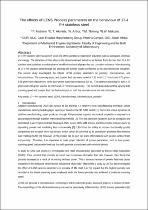 ResearchSpace
ResearchSpace
The effects of LENS process parameters on the behaviour of 17-4 PH stainless steel
JavaScript is disabled for your browser. Some features of this site may not work without it.
- ResearchSpace
- →
- Research Publications/Outputs
- →
- Conference Publications
- →
- View Item
| dc.contributor.author |
Mathoho, Ipfi

|
|
| dc.contributor.author |
Akinlabi, ET

|
|
| dc.contributor.author |
Arthur, Nana KK

|
|
| dc.contributor.author |
Tlotleng, Monnamme

|
|
| dc.contributor.author |
Makoana, Nkutwane W

|
|
| dc.date.accessioned | 2020-11-02T10:53:36Z | |
| dc.date.available | 2020-11-02T10:53:36Z | |
| dc.date.issued | 2020-02 | |
| dc.identifier.citation | Mathoho, I. (et.al). 2020. The effects of LENS process parameters on the behaviour of 17-4 PH stainless steel. TMS 2020 149th Annual Meeting & Exhibition Supplemental Proceedings, San Diego, California, United States of America, 23-27 February 2020, pp 481-490. | en_US |
| dc.identifier.isbn | 978-3-030-36295-9 | |
| dc.identifier.isbn | 978-3-030-36296-6 | |
| dc.identifier.uri | https://doi.org/10.1007/978-3-030-36296-6_45 | |
| dc.identifier.uri | https://link.springer.com/book/10.1007/978-3-030-36296-6 | |
| dc.identifier.uri | http://hdl.handle.net/10204/11655 | |
| dc.description | Copyright: 2020 Springer. This is the pre-print version of the work. For access to the published item, kindly access the publisher's website. | en_US |
| dc.description.abstract | 17-4 PH stainless steel has proven to be one of the workhorse materials in industries such as aerospace, chemical, and energy. The attraction of this alloy to the aforementioned industries is derived from the fact that 17-4 PH stainless steel possesses a combination of excellent mechanical properties and corrosion resistance. Manufacturing of 17-4 PH stainless steel through 3D printing will further inspire confidence in the aforementioned industries. The current study investigated the effects of LENS process parameters on porosity, microstructure, and microhardnesss. The scanning speed and powder feed rate were varied at 7.62 mm/s-12.7 mm/s and 4.70 g/min-5.98 g/min rpm, respectively, while laser power was kept constant at 300 W. The optimum scanning for both 4.70 g/min and 5.98 g/min was 10. 16 mm/s and 12.7 mm/s, respectively. The current study deduced that varying both scanning speed and powder feed rate had an impact on both the microstructure and microhardness | en_US |
| dc.language.iso | en | en_US |
| dc.publisher | Springer | en_US |
| dc.relation.ispartofseries | Worklist;23701 | |
| dc.subject | 17-4 PH stainless steel | en_US |
| dc.subject | Laser Engineered Net Shaping | en_US |
| dc.subject | LENS | en_US |
| dc.subject | Microhardness | en_US |
| dc.subject | Microstructures | en_US |
| dc.subject | Porosity | en_US |
| dc.title | The effects of LENS process parameters on the behaviour of 17-4 PH stainless steel | en_US |
| dc.type | Conference Presentation | en_US |
| dc.identifier.apacitation | Mathoho, I., Akinlabi, E., Arthur, N. K., Tlotleng, M., & Makoana, N. W. (2020). The effects of LENS process parameters on the behaviour of 17-4 PH stainless steel. Springer. http://hdl.handle.net/10204/11655 | en_ZA |
| dc.identifier.chicagocitation | Mathoho, Ipfi, ET Akinlabi, Nana KK Arthur, Monnamme Tlotleng, and Nkutwane W Makoana. "The effects of LENS process parameters on the behaviour of 17-4 PH stainless steel." (2020): http://hdl.handle.net/10204/11655 | en_ZA |
| dc.identifier.vancouvercitation | Mathoho I, Akinlabi E, Arthur NK, Tlotleng M, Makoana NW, The effects of LENS process parameters on the behaviour of 17-4 PH stainless steel; Springer; 2020. http://hdl.handle.net/10204/11655 . | en_ZA |
| dc.identifier.ris | TY - Conference Presentation AU - Mathoho, Ipfi AU - Akinlabi, ET AU - Arthur, Nana KK AU - Tlotleng, Monnamme AU - Makoana, Nkutwane W AB - 17-4 PH stainless steel has proven to be one of the workhorse materials in industries such as aerospace, chemical, and energy. The attraction of this alloy to the aforementioned industries is derived from the fact that 17-4 PH stainless steel possesses a combination of excellent mechanical properties and corrosion resistance. Manufacturing of 17-4 PH stainless steel through 3D printing will further inspire confidence in the aforementioned industries. The current study investigated the effects of LENS process parameters on porosity, microstructure, and microhardnesss. The scanning speed and powder feed rate were varied at 7.62 mm/s-12.7 mm/s and 4.70 g/min-5.98 g/min rpm, respectively, while laser power was kept constant at 300 W. The optimum scanning for both 4.70 g/min and 5.98 g/min was 10. 16 mm/s and 12.7 mm/s, respectively. The current study deduced that varying both scanning speed and powder feed rate had an impact on both the microstructure and microhardness DA - 2020-02 DB - ResearchSpace DP - CSIR KW - 17-4 PH stainless steel KW - Laser Engineered Net Shaping KW - LENS KW - Microhardness KW - Microstructures KW - Porosity LK - https://researchspace.csir.co.za PY - 2020 SM - 978-3-030-36295-9 SM - 978-3-030-36296-6 T1 - The effects of LENS process parameters on the behaviour of 17-4 PH stainless steel TI - The effects of LENS process parameters on the behaviour of 17-4 PH stainless steel UR - http://hdl.handle.net/10204/11655 ER - | en_ZA |





